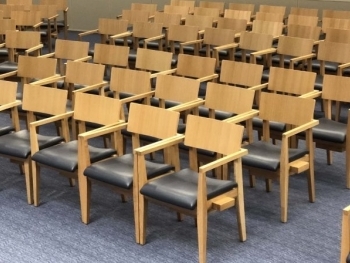The design and comfort of church seating have evolved significantly over the years, reflecting changes in architectural styles, congregational needs, and ergonomic research. Among the various seating options available today, church chairs with armrests have become increasingly popular. This detailed article explores the history, design, benefits, and considerations involved in choosing church chairs with armrests.
Historical Perspective
Early Church Seating
The earliest Christian churches often lacked permanent seating. Worshippers stood or sat on the floor, and the few available seats were typically reserved for clergy and notable community members. Over time, pews became the standard, offering long, bench-like seating without individual armrests. These pews were often made of wood, rigid and unpadded, reflecting the austere and communal nature of early worship practices.
Introduction of Individual Seating
As church architecture evolved, particularly during the Gothic and Renaissance periods, the focus on individualism and personal space began to influence church interiors. Individual chairs started to appear, primarily in cathedrals and larger churches. These chairs, often ornate and made of wood, sometimes featured armrests, signaling status and comfort.
Modern Church Seating: The Rise of Comfort and Inclusivity
In the 20th and 21st centuries, the shift towards more inclusive and comfortable worship environments has been significant. The modern church aims to create a welcoming space for all congregants, including the elderly, disabled, and those requiring additional support. This shift has driven the demand for more ergonomic and comfortable seating solutions, including chairs with armrests.
Benefits of Church Chairs with Armrests
Enhanced Comfort and Support
Chairs with armrests provide enhanced comfort by allowing congregants to rest their arms, reducing strain on shoulders and upper back muscles. This is particularly beneficial during long services or events, where prolonged sitting can lead to discomfort.
Accessibility and Inclusivity
Armrests are crucial for individuals with mobility issues or disabilities. They offer support for those who may struggle to sit down or stand up without assistance. This makes the church more accessible and inclusive, aligning with many congregations' values of welcoming all members of the community.
Improved Posture
Good posture is essential for preventing musculoskeletal issues. Chairs with armrests encourage proper sitting posture by providing support to the arms and promoting a more upright seating position. This can be particularly beneficial during services that involve extended periods of sitting.
Versatility and Functionality
Modern church chairs with armrests often feature stackable designs, making them versatile for various church activities. They can be easily arranged for regular services, special events, or moved to create space for other activities. Many models also include options for attaching kneelers, book holders, or writing tablets, adding to their functionality.
Design Considerations
When choosing church chairs with armrests, several design considerations should be taken into account:
Material and Durability
The material of the chair frames and upholstery plays a crucial role in durability and comfort. Metal frames, often made from steel or aluminum, offer strength and longevity, while wooden frames provide a more traditional aesthetic. Upholstery materials range from vinyl and leather to various fabrics, each offering different levels of comfort, maintenance, and durability.
Ergonomics
Ergonomic design is essential for ensuring the chairs provide adequate support and comfort. Features such as contoured seats, lumbar support, and appropriate armrest height should be considered. Chairs should accommodate a wide range of body types and sizes to ensure inclusivity.
Aesthetics
The visual appeal of the chairs should complement the church’s interior design. Chairs come in various styles, from traditional to contemporary, and in a wide range of colors and finishes. The choice should reflect the church’s overall aesthetic and the ambiance it aims to create.
Cost
Budget considerations are always crucial. While church chairs with armrests can be more expensive than their armless counterparts, their benefits often justify the additional cost. Churches must balance the need for quality and durability with budget constraints, considering long-term investment over initial expenditure.
Stackability and Storage
For churches that require flexible space usage, stackable chairs with armrests are an excellent option. They can be easily stored when not in use, allowing the space to be adapted for different activities. Some models also come with trolley systems for easier transportation and storage.
Case Studies: Successful Implementation
Traditional Churches
Many traditional churches have successfully transitioned from pews to chairs with armrests, finding that the increased comfort and accessibility enhance the worship experience. For instance, St. Mark’s Cathedral in Seattle replaced its old wooden pews with cushioned chairs featuring armrests, significantly improving congregants' comfort during long services and events.
Contemporary Worship Spaces
Modern churches often favor flexible seating arrangements to accommodate various activities. The Saddleback Church in California, known for its contemporary worship style, uses stackable chairs with armrests that can be easily rearranged for different events, reflecting the church’s dynamic and inclusive approach.
Multi-Use Facilities
Churches that serve as community centers or host multiple events outside of worship hours benefit from versatile seating solutions. The Community Church of Joy in Arizona uses chairs with armrests that are comfortable for both worship services and community events, ensuring all attendees feel welcome and supported.
Church chairs with armrests represent a thoughtful evolution in church seating, addressing the need for comfort, inclusivity, and versatility. By understanding the benefits and design considerations, churches can make informed choices that enhance the worship experience for all congregants. As the trend towards more welcoming and comfortable worship spaces continues, chairs with armrests are likely to become an increasingly common feature in churches around the world.




